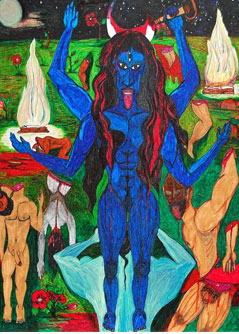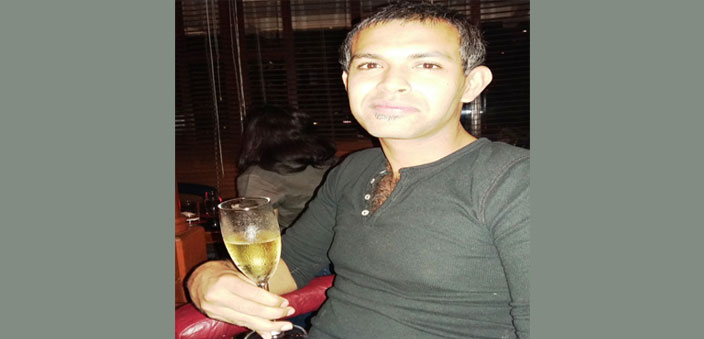Let us hear about your childhood.
I had a fiercely sheltered and over-protective childhood, and hardly ventured out of home alone. I do not blame my parents because firstly, I was dyslexic, and secondly, I suffered from ADHD that in full, spells out as Attention Deficit Hyperactive Disorder. I was a slow reader with little patience, and was mediocre in academics. The only thing that brought me pleasure at the time was sketching on any and every available surface I could sketch and draw on. Pens were not allowed anywhere near me because of this very bad habit of drawing on walls. It was mythology that inspired me in my drawings because my father had nourished in me a love for mythological stories. I had a very good visual memory that made me recall each story in pictures, which I would then translate and transform to make my own drawings.
How and when did the transformation begin and proceed?
I went to different schools in Kolkata as a child. Then, I was packed off to Mt. Herman School in Darjeeling for a year. My life changed dramatically in every way. It shocked me into accepting life in a dormitory with 60 other boys, after the sheltered and protected life back home where I could get whatever I asked for, be it ice-cream or rolls or whatever. I had to teach myself to share a single shower with the other boys, and this learning experience changed me forever. I stayed there only for a year, but that year played an extremely crucial role in my life.
Tell us about your living experience in the US.
I was sent to a public school at Danville, a small village in east central Illinois. Then I went to the University of Illinois in Urbana-Champaign (UIUC), followed by Thomas M. Cooley Law School in Lansing, Michigan, and finally to DePaul University in Chicago, Illinois. Life was quite tough though, and one had to work one’s way through academics. I worked as a bank teller, nightclub manager, library technician, teaching assistant, victim’s counsellor, county prosecutor and an AmeriCorps member, and grew up along with these experiences.

(Photo credit: Oeishik)
What was the turning point?
In 2011, I began my writing platform and called it The Tribute Projects at www.tributetosam.com and over the last five years, this endeavour has evolved from an experiment on introspective exploration, to an art and writing medium that explores what I term “intersectional identity.” It began as part of my curriculum at De Paul, but grew even after I left the University. Somewhere along the way my learning disabilities turned into developmental enhancements. I wrote for fifteen minutes, skipped over to sketching for thirty, and back to writing for twenty. I wrote and drew what came naturally, from memory, and never used an eraser. In fact, I inadvertently began sketching with ball-point pens.
What do you mean by ‘intersectional identity’?
Intersectional Identity to me means a singular human identity built as a result of one’s personal response to all competing social paradigms (sex, race, sexuality, nationality, etc.) within one’s life. That is to say, I am not denying the presence of these paradigms and imbibe them into my art and my writing, but I refuse to be negatively influenced or dominated by them. In other words, they must reflect in my art and writing, but not overpower these forms of self-expression.
Who would you consider your mentors and sources of inspiration?
My father nurtured my habits, sometimes beyond reason. He gave me the pleasure of the company of his most sacred influence – his friend and mentor, Suchitra Mitra. A surrogate grandmother and the linchpin of my understanding of myself, my voice and my creative potential, I remember her gifting me clay Durga idols until I had broken too many, and eyed her bronze figurines; and who instructed me to never use an eraser while drawing – make mistakes, learn from them; have faith in what you draw. Her teachings became the foundation of my faith.
You came back to India in 2014. Why?
I had already decided to turn my life around while I was there. I did not want to practice law, and decided to follow my creative instincts in fine arts and in writing. No matter what I sketched or wrote, I always came back to my roots. Memories of the past haunted me.
For over a decade, through heartbreaks and fallouts, challenges and failures, victories and lessons, I had locked away my foundational identity behind the curtain of social conformity. I had forced myself to go with the grain despite being the outsider. And I could no longer keep that up. By 2014, I had written hundreds of pages and produced dozens of sketches – but I could not reach my potential. Something was lacking; I was still just staring at the Kanchenjunga when what I really needed was to sit in the stillness of its gleaming peak. I decided to come back to Kolkata in July 2014.
After eleven long years of absence, was it another culture shock for you?
I suffered from a strong case of westernisation the first year; remnants of battles of bygone eras that upended my childhood, burdened me; and the humidity and pollution made breathing hard. But my creativity matured by leaps and bounds. By the end of 2014, I produced another few dozen pieces of short prose, expanded Shorbomongol, my first collection of art from the original six to thirty-four pieces, and started Nature, the second collection.

(Photo credit: Oeishik)
Tell us something about Alo and Lalon.
In the summer of 2015 I adopted two bullmastiff puppies named Lalon and Alo, and my life changed in ways I could have never imagined. I went back to meditation and prayer. I devoted myself wholly to the puppies. As I do a bulk of my work at my desk, I have the pleasure of watching them grow before my eyes. This led to my third collection of sketches called Sleep, inspired by watching Alo and Lalon sleeping contentedly beside me, oblivious to everything and everyone. Over the past year, I have done more than 40 life sketches of Alo and Lalon, and these were part of my first solo show in Kolkata called Alo, Lalon and Others.
What other things does your art reflect?
I have produced three new pieces for Shorbomongol, four additional ones for Nature, and introduced Mélange, homages in collage, the fourth collection. These became my entire exhibition which, thanks to my friend, mentors and organiser, Shounak Chacreverti, a noted art collector and curator, has been a thundering success in terms of footfalls, and also in terms of sales.
What does “others” stand for in the exhibition you held?
“Others” stands for my tribute to the Mother Goddess in brilliant primary pen-and-ink paintings. Alo and Lalon are line drawings in black pen-and-ink while the “Others” are in brilliant colour, offering an enlightening male perspective of the Goddess from the Hindu pantheon. They were the ones that captured the attention of the visitors and some bought some of these right away.

